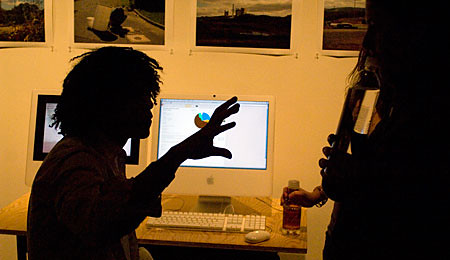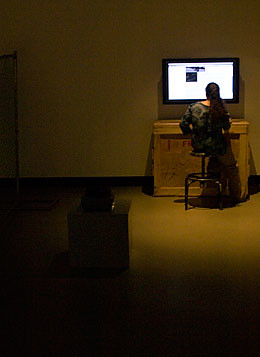![]()
Internationally recognized artists interacted with students and faculty members at a weekend symposium focused on finding innovative solutions to pressing environmental problems.
“How can we re-imagine our relationship to natural systems?” asked Natalie Jeremijenko, the keynote speaker of the seminar titled Environmental Art and New Media Technologies: Imagining Sustainable Futures.
All of the weekend’s panels, presentations, and performances addressed that question.
 |
| One of the multimedia displays focusing on ecological problems sparks discussion during an artists’ reception Friday at Clifford Gallery. (Photo by Luke Connolly ’09) |
The presentations included Jeremijenko’s “Ooz,” a zoo without cages that allows humans and animals to interact “on the animal’s terms,” Amy Franceschini’s “Victory Gardens” that create a network of local food producers, and Andrea Polli’s “90 Degrees South,” a series of sonifications portraying the changes occurring in New York City because of global warming.
“[The artists] are creating situations that ask us to imagine more sustainable futures that aren’t primitive futures,” said Cary Peppermint, assistant professor of art and art history who organized the symposium with Bob Turner, professor of environmental studies. “It is a way of working that problematizes old notions about technology and environmentalism being incompatible opposites.”
This theme of technology and reinvention is one explored in Peppermint’s New Media Art: History/Theory course that he co-teaches with Christine Nadir.
 |
| A guest interacts with one of the digital works on display at the Nature Version 2.0 exhibition. (Photo by Luke Connolly ’09) |
“It’s a class that critically looks at a lot of the consumer devices that are integrated as part of our daily lives,” said Peppermint. “We ask questions like, ‘Why did these technologies emerge at these times? How did these technologies emerge?’ We investigate how contemporary artists are using these technologies and even further, we’re looking at how [they] use these technologies in creative ways that were never intended.”
Because of the complexity of the subject, the accessibility to the artists that the symposium provided made it particularly appealing to students.
“It took it out of the classroom environment into a more real-life setting,” said John Emison ’09. “It allowed us to have interactions with the artists that we’re learning about and breached the gap between class and real life.”
The symposium was part of the Institute for the Creative and Performing Arts’ Forum on the Arts. It was sponsored by the Department of Art & Art History, Film & Media Studies Program, and the Environmental Studies Program.
It comes on the heels of the daylong Focus the Nation event, in which Colgate joined hundreds of other universities and organizations to address global warming. The university’s Center for Ethics and World Societies also is examining global warming throughout the year.